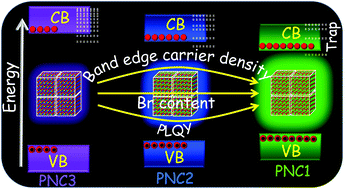Unravelling halide-dependent charge carrier dynamics in CsPb(Br/Cl)3 perovskite nanocrystals†
Abstract
With an increasing bromide content in CsPb(Br/Cl)3 perovskite nanocrystals (PNCs), the steady state photoluminescence quantum yield value increases from 28% to 50% to 76%. Ultrafast transient absorption analyses reveal that the normalized band edge population increases more than two-fold on excitation at the band edge with increasing bromide content, and the hot exciton trapping time increases from 450 fs to 520 fs to 700 fs with increasing bromide content. Ultrasensitive single particle spectroscopic analyses reveal that the peak of the ON fraction distribution increases from 0.65 to 0.75 to 0.85 with increasing bromide content. More specifically, the percentage of PNCs with the ON fraction >75% increases four fold from 24% to 50% to 98% with increasing bromide content. Moreover, the ratio of the detrapping rate and trapping rate increases more than 25 fold with an increase in bromide content, signifying the excitons remaining in the trap state for a smaller time with increasing bromide content. In order to standardize the measurement and analyses, all these three PNCs have the same size and shape, and all the excitations have been made at the same energy above the band edge for all three PNCs and for both ultrafast transient absorption and ultrasensitive single particle measurements.



 Please wait while we load your content...
Please wait while we load your content...